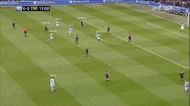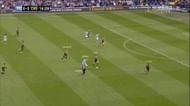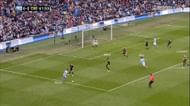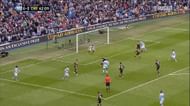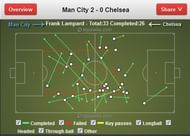MANCHESTER, ENGLAND – FEBRUARY 24: Carlos Tevez of Manchester City celebrates after scoring the second goal during the Barclays Premier League match between Manchester City and Chelsea at Etihad Stadium on February 24, 2013 in Manchester, England. (Photo by Alex Livesey/Getty Images)
The clash of the Blues from England’s two biggest cities, London and Manchester, promised a lot, and yet turned out to be a rather one–sided affair in the end. Both have assembled an expensive squad over the years, and – at least on paper – are probably the two strongest sides in the league. So it was natural that football of the highest calibre was expected from the match, yet it petered out towards the end with Manchester City clearly dominating every position on the pitch, and eventually running out comfortable 2-0 winners.
Roberto Mancini, who recently lost his cool in rather unceremonious circumstances in a press conference, knew that he had to win this game at any cost. Before the game, they were a mighty 15 points behind Manchester United, and a loss against Chelsea would have certainly been Game Over for them. Hence, it was a big surprise when City’s team sheet came out. Tevez, Nasri, Dzeko – all started on the bench, whereas Mancini went with a rather physical, energetic and industrious midfield of Javi Garcia, Rodwell, Milner and Y. Toure. The game plan was clear – stifle the creativity in Chelsea’s midfield and do not allow them to keep possession.
Benitez stuck to a more tried and tested formation of 4-2-3-1 with Ba upfront instead of Torres. However, the selection of Ivanovic at right back in place of Azpilicueta clearly emphasized Benitez’s game plan to thwart Silva and Aguero’s movements down that flank.
The team sheet suggested that Aguero would play as a lone striker, with Y. Toure playing behind him while Silva and Milner operated on the flanks. However, Mancini had other plans. Manchester City overloaded the midfield. Milner played in more a central position and occasionally drifted out to the right to offer support to Zabaleta when needed. Jack Rodwell was asked to move up the pitch and play close to Y. Toure and Silva, and he also made constant runs into the Chelsea penalty box to get on the end of crosses.
The above diagram show the action areas of Jack Rodwell and James Milner.
It is thus evident that Jack Rodwell played more as an attacking midfielder alongside Yaya Toure and also ventured regularly in the box.
James Milner shuffled between central midfield and right wing. This also helped in restricting the space for Lampard to operate in midfield.
Since the Manchester City midfield became narrow, Chelsea’s full backs drifted towards the centre too. This made Chelsea compact through the middle. However, it also gave City’s wing backs ample space to run into down the flanks and stretch play easily.
A clear example of the same can be seen below –
Here, both Ivanovic and Ramires come inside, leaving the entire left flank empty for Clichy to run into. Clichy, who is not in the frame here, a few seconds later makes a run down that flank and delivers a cross, albeit without causing any damage.
Here is another instance where A. Cole and Hazard have both dropped in too narrow, allowing Zabaleta (who is not in the frame here) to make a run down the right flank and whip in a dangerous cross. Fortunately for Chelsea, Gary Cahill, who had an excellent game, did enough to deny Aguero.
Chelsea’s midfield were certainly outnumbered and overpowered by City’s midfield. Lampard and Mikel never got in the face of their opponents, and gave them the time to look up and pick a pass comfortably. They dropped deeper and deeper as the game went on, particularly Mikel. Their marking was also lacklustre, to say the least, and it comes as no surprise that they played a huge part in City’s first goal.
Both Mikel and Lampard completely ignore Silva and leave him free. He is allowed to run behind into the space between Mikel and Cahill. Silva then lays it back to Yaya Toure, who easily waltzes past Mikel and Lampard and places it into the corner beautifully. Had Lampard or Mikel stopped Silva initially or had they not allowed Toure to run into the box, the goal could have been easily avoided.
As Chelsea’s midfield sat deep, the gap between Chelsea’s forward line and the midfield increased. This made it difficult for Chelsea to quickly get the ball into the attacking third when they won possession. Lampard’s passing statistics also have a story to say. Lampard made a total of 33 passes during the match, out of which only 13 passes were made in the opposition half. Compare this to his passing statistics in the Chelsea vs Wigan match, where he made a total of 53 passes out of which 33 were in the opposition half.
Clearly, Chelsea felt the absence of someone who could link midfield to attack and could also spark counter attacks. Generally, it is Lampard who does that job, but even he operated from the deep during the game, and his influence in the attacking third was very limited.
Lampard was very much involved in the attacking third against Wigan, whereas against City, he was pinned back into his own half more often than not. His creativity and vision was stifled and he was unable to operate in the final third of the pitch, where he is at his devastating best. The penalty miss summed up his game perfectly.
Due to their inability to build the game in midfield, Chelsea resorted to pumping long balls behind the City defence. It was effective to some extent as City pressed higher up the pitch, leaving gaps behind for Ba and Hazard to run into. And not so surprisingly, it was a long ball from Ivanovic to Ba that resulted in the penalty.
After going a goal down, Benitez tried to alter the midfield by substituting Lampard and Hazard with Moses and Oscar. They started getting the ball into wider areas more often and got crosses in. Chelsea had 29 crosses in the match in comparison to City’s 22. However, they completed only 6 of them as their crosses were poor and the mean City defence was up to the task as well. Even the arrival of Torres wasn’t enough to spark a comeback for Chelsea, who, for all the possession they had (most of which was in their own half), couldn’t create much from it.
Mancini brought on Tevez for Rodwell in the second half, which was a bit harsh on Rodwell considering his performance. Tevez now played through the centre, allowing Aguero to go down the left and drift inside. In the second half, there were two instances when Aguero got clear of his marker and was clean through on goal. Tevez would draw the central defender into midfield, which allowed Aguero to make runs towards the centre into the space vacated by the central defender.
The second goal looked more like a formality, although the strike from Tevez was incredible. Aguero won the ball in midfield and drew three Chelsea players towards him before laying it off to Silva. Silva then passed it to Tevez, who himself would have been surprised at the amount of time that he actually got to look up and take a shot from so far out. Chelsea’s midfield and defence made no attempt to close him down and they paid for it.
- David Silva made 53 passes in the game, with a pass completion of 91%. Mata had the highest number of passes in the game with 57.
- Silva made 8 key passes, the most by any player in the match, and two of those resulted in goals.
- Silva put in 8 crosses during the game, 4 of which found its target in the middle.
- Surprisingly, Silva made 5 tackles in the game, of which all five were successful. No other player on the pitch made more than 4 tackles in the game.
So clearly, Mancini was hugely successful in crowding the midfield and denying Chelsea space to pass the ball. At the same time, Chelsea sat too deep and allowed City to pass the ball around in the final third. Chelsea were also ineffective on the counter attack, and were let down by bad touches when in good positions. It may now seem that David Luiz in midfield could have been a better option, with Lampard playing behind Ba and Mata playing in Ramires’ position. However, City got the victory in the end and Mancini would surely be pleased with the performance.
With this result, Benitez and Chelsea find themselves in a precarious position with Tottenham and Arsenal gunning for the 3rd spot. As of now, Tottenham have leapfrogged them into 3rd after their win against West Ham.
Manchester City live to fight another day in the title race, and Mancini certainly won’t be giving up that easily, not until the final whistle of the season.

